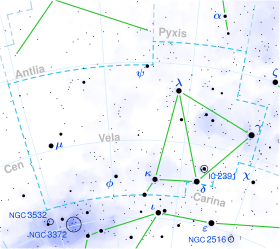Omicron Velorum
| Observation data Epoch J2000.0 Equinox J2000.0 |
|
|---|---|
| Constellation | Vela |
| Right ascension | 08h 40m 17.58553s |
| Declination | –52° 55′ 18.8002″ |
| Apparent magnitude (V) | +3.60(3.57 - 3.63) |
| Characteristics | |
| Spectral type | B3 IV |
| U−B color index | –0.62 |
| B−V color index | –0.18 |
| Variable type | SPB |
| Astrometry | |
| Proper motion (μ) |
RA: –24.42 mas/yr Dec.: +34.44 mas/yr |
| Parallax (π) | 6.61 ± 0.35mas |
| Distance | 490 ± 30 ly (151 ± 8 pc) |
| Details | |
| Mass | 5.5 ± 0.4 M☉ |
| Radius | 4.3 ± 0.7 R☉ |
| Luminosity | 1,000 L☉ |
| Surface gravity (log g) | 3.91 ± 0.20 cgs |
| Temperature | 16,200 ± 700 K |
| Rotational velocity (v sin i) | 9 ± 5 km/s |
| Other designations | |
| Database references | |
| SIMBAD | data |
Omicron Velorum (ο Vel, ο Velorum) is a star in the constellation Vela. It is the brightest member of the loose naked eye open cluster IC 2391, also known as the ο Velorum Cluster.
Omicron Velorum is a blue-white B-type subgiant with a mean apparent magnitude of +3.60. It is approximately 495 light years from Earth. A slowly pulsating B star, it ranges between magnitudes 3.57 and 3.63 over 2.8 days.
The correct Bayer designation for ο Velorum has been debated. Lacaille assigned one Greek letter sequence for the bright stars of Argo Navis. These Lacaille designations are now shared across the three modern constellations of Carina, Puppis, and Vela so that the same Greek letter is not usually found in more than one of the three. However, ο (omicron) is commonly used for stars in both Vela and Puppis. Some authors contend that Lacaille actually assigned a Latin lower case 'o' to this star, while others suggest that ο Puppis should actually be a lower case 'o'.
...
Wikipedia

